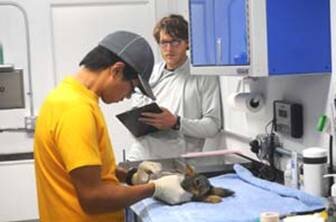IWS developed a mobile wildlife research hospital to support field projects that require high-level veterinary or laboratory support. The hospital was built in a 48’ gooseneck trailer, which allows it to be moved between locations with relative ease.
The hospital consists of three main rooms: an office/laboratory space, a holding and treatment area for patients, and an operating room.
The laboratory has the necessary equipment to conduct standard veterinary blood analyses using a hospital hematology machine, a serum chemistry analyzer, centrifuges, and a microscope. Stable storage of blood and other tissues are supported in our -80° C freezer. The laboratory also has an autoclave for sterilizing instruments as well as computer and internet resources.
The patient room contains stainless steel cages for holding patients, an x-ray machine and developer, a wet sink for patient preparation, and a patient exam area with the necessary holding space for medical supplies.
The operating room provides full surgical capability, including a surgery table and light, patient monitor, anesthesia machine, oxygen generator and back-up oxygen tanks, IV fluid pumps, ultrasound and circulating heating pad. The equipment in the trailer can be operated by external power sources or by a self-contained gas-powered generator.
The hospital is currently providing medical support on San Clemente Island, mainly for injured island foxes.
Previously, the hospital was on San Nicolas Island to support an effort to restore seabird populations through the live-capture and removal of feral cats from the island. IWS cared for injured island foxes, whether or not the injury was the result of feral cat trapping efforts. We also provided temporary care for the captured feral cats as they waited to be transported to a facility on the mainland (operated by the Humane Society of the United States) that will provide long-term care for the cats. This project was funded by the Montrose Settlements Restoration Program, which also funds the bald eagle restoration program on the Channel Islands (see our Bald Eagle pages), peregrine falcon monitoring, and other important programs.

IWS biologists obtain a blood sample for analysis from an anesthetized feral cat.

IWS biologists examine an island fox and record physical data.

IWS veterinarian Winston Vickers prepares to x-ray an island fox to assess its injuries.


Preparing for, and conducting, surgery on the foxes leg




